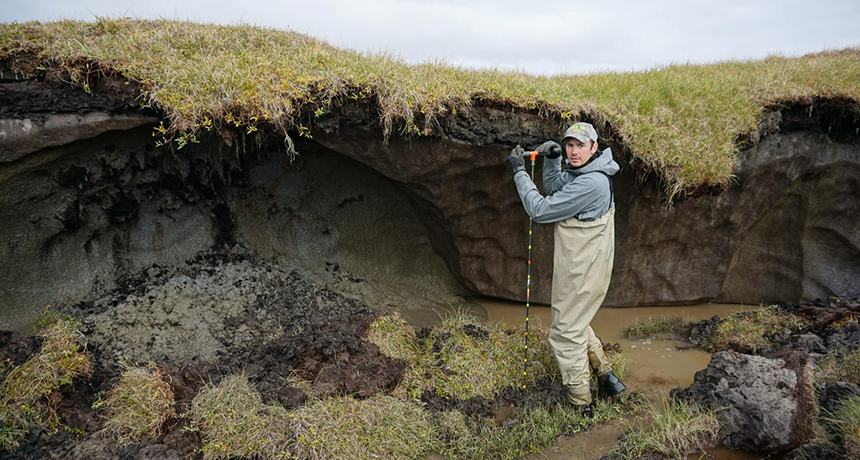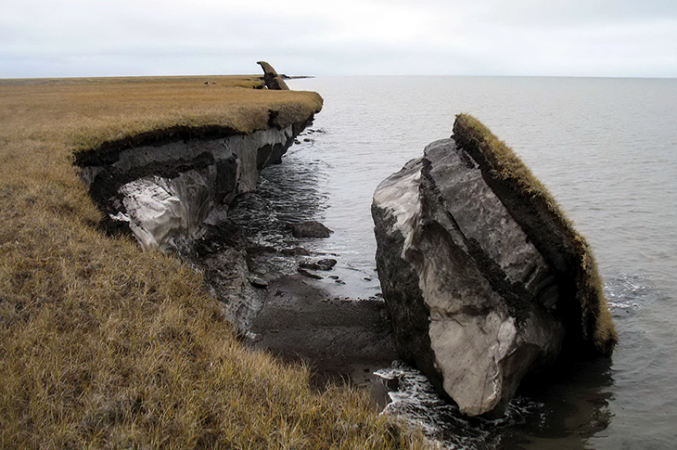Earth’s permafrost is heating up
Climate change is warming soil that’s been frozen for centuries — and in some places thawing it

As climate change brings warmer temperatures to the Arctic, the permafrost along this lakeshore in northern Alaska is thawing and falling apart.
Benjamin Jones/USGS
By Sid Perkins
It’s no secret that climate change is melting Earth’s ice caps and glaciers. In many cases, the ice is disappearing right before our eyes. Less well known has been what’s happening below ground. A first-of-its kind global survey has just revealed that the planet’s permafrost is also warming. Scientists now worry that could help make the planet even hotter.
Permafrost is frozen soil, but not the type you might find in your yard in winter. This soil has to stay frozen constantly for at least two years to qualify as permafrost. Near the poles and high in the mountains, some permafrost has remained frozen since the last ice age ended thousands of years ago. And we’re not just talking about a thin layer of soil. In many places, permafrost is more than 10 meters (33 feet) thick, notes Boris Biskaborn. He’s a polar researcher at the Alfred Wegener Institute in Potsdam, Germany.
But this frigid dirt is in danger. Since the Industrial Revolution, the planet has been warming. On average, Earth has warmed by about 1 degree Celsius (1.8 degrees Fahrenheit) since 1850. Air temperatures in polar regions, especially the Arctic, have warmed even more. Over time, this extra heat has gradually soaked into the ground, warming it, too.
In many places, the effects of thawing permafrost are obvious. Once-stable shorelines have been tumbling into the sea. Once-frozen landscapes are turning to mush. Such changes can undermine roads and weaken the foundations of buildings. But Biskaborn and his colleagues wanted to assess less-obvious sites, ones far underground.
They turned to soil collected from a number of deep boreholes. Some bores had been drilled by other teams many years ago, for various studies. Others were drilled more than a decade ago as part of a two-year-long study of polar regions. The holes were bored in North America, Europe, Asia and Antarctica. In all, the team identified more than 120 boreholes where the data record covered a decade. That 10-year period stretched from 2007 through 2016.
Close to the surface, soil temperature changes with the seasons. But if you dig far enough down, you’ll reach a depth where the permafrost temperature stays the same year-round. For each borehole, the team found that depth. It was usually at least 10 meters (33 feet) underground.
Then the researchers looked at how permafrost temperature at that depth had changed over time. In soils from 40 of the boreholes, permafrost temperature had been stable from 2007 through 2016. In 12 of the holes, the permafrost cooled slightly. But in 71 boreholes, permafrost temperature warmed quite a bit.
Biskaborn’s team reported its findings January 16 in Nature Communications.

Not so permanent?
In northern North America, permafrost warmed up an average of 0.23 degree C (0.41 degree F). In northern Asia, frozen soil warmed up by 0.33 degree C (0.59 degree F). In mountainous regions, permafrost warmed by 0.19 degree C (0.34 degree F). Worldwide, the planet’s permafrost has warmed an average of about 0.29 degree C (0.52 degree F).
Half a degree Fahrenheit doesn’t sound like a lot of warming. But it may not take much to melt some permafrost. In five of the boreholes, soil temperature rose above freezing (0 °C, or 32 °F). At these sites, the permafrost had thawed.
When permafrost thaws, it can have consequences far beyond the local landscape, notes Ted Schuur. He’s an ecosystems ecologist at Northern Arizona University in Flagstaff. Yes, he notes, when permafrost on the ground’s surface thaws, it affects roads, bridges and buildings. But it also affects lakes, streams and other ecosystems. For example, when permafrost thaws, shrubs can take hold and grow. That, in turn, means the landscape can support more herbivores such as moose, hares and birds.
And there’s more. Permafrost holds the remains of plants that lived and died long ago. While they were alive, those plants took up carbon from the atmosphere, just as plants do today. But thawing permafrost could unlock that carbon. If ice melts and the water drains away, that lets oxygen reach the dead plants. Now they can start to decompose.
Their rotting may generate vast amounts of carbon dioxide, explains Schuur. It could also support the growth of methane-making microbes in the soil. As those microbes thrive, they will release large amounts of methane, another climate-warming greenhouse gas. This might make global climate change even worse. This is why effects of thawing permafrost can affect people living as far away as the tropics, Schuur says.
A few years ago, he was part of a team that in 2015 estimated the possible effects of thawing permafrost. They used detailed computer programs for their study. By the year 2100, they estimated, thawing permafrost could release enough carbon dioxide and methane to raise the average global temperature by 0.13 to 0.27 degree C (0.23 to 0.49 degree F).
That increase, Schuur notes, would be in addition to any boost in global temperatures from the greenhouses gases that factories and farms emit during that time. And it would be on top of the 1 degree C (1.8 degrees F) that average temperatures have already risen since 1850.
“Warming permafrost is a largely unknown dimension of climate change,” Schuur says. The new study shows that deep underground in chilly, remote parts of the world, big changes may be brewing.







